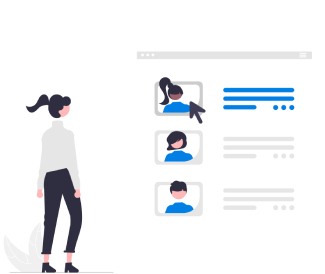What Does Total Experience Mean in HR?
Total Experience is an integrated approach that combines employee experience (EX), customer experience (CX), user experience (UX), and multi-experience (MX) to deliver a connected and consistent journey across all touchpoints.
In simpler terms, it's how your employees feel when working, how your customers feel when interacting with your brand, and how technology supports both experiences, all working in harmony.
In HR, this concept goes beyond employee engagement surveys or one-off satisfaction initiatives. It's about designing processes, tools, and environments that benefit both employees and customers simultaneously.
For instance, when HR implements a modern HRMS platform like Qandle, it doesn't just make employees' lives easier, it also enhances how customers experience your brand because happy employees create happier customers.
Example: Imagine a retail company where employees can access their schedules, payroll, and performance reviews easily via a mobile app. This improved digital experience leads to better morale and faster customer service, boosting both EX and CX simultaneously. That's Total Experience in action.
TL;DR --- Summary!
- Total Experience (TX) combines employee, customer, and user experiences into one holistic strategy.
- It ensures smoother interactions between employees, customers, and technology.
- TX helps HR teams enhance productivity, engagement, and brand loyalty.
- Unlike employee or customer experience alone, TX focuses on every touchpoint in the ecosystem.
- In 2025 and beyond, businesses investing in TX will enjoy better retention, higher satisfaction, and long-term growth.
- Implementing TX requires digital tools like HRMS software, continuous feedback loops, and people-first policies.
How Is Total Experience Different from Employee Experience and Customer Experience?
While employee experience and customer experience are well-known concepts, Total Experience takes things a step further. Here's how they differ:
| Aspect | Employee Experience (EX) | Customer Experience (CX) | Total Experience (TX) |
|---|---|---|---|
| Focus | Employees and their workplace journey | Customers and their interactions with the brand | Integration of EX, CX, UX, and MX |
| Goal | Improve engagement, productivity, and retention | Boost satisfaction, loyalty, and brand trust | Align internal and external experiences for better business outcomes |
| Approach | HR-led and internally focused | Marketing or service-led and externally focused | Collaborative and organization-wide |
| Tools Used | HRMS, feedback tools, learning platforms | CRM, support systems, marketing automation | Unified digital platforms connecting both sides |
So, while EX or CX focuses on improving one side of the experience, TX brings them together to create a holistic, win-win environment.
For example, when HR implements a self-service HR management system, it streamlines internal workflows (helping employees) and speeds up response times for customer queries (helping customers).
That's why Total Experience is considered a business strategy, not just an HR initiative.
Why Should You Focus on Total Experience in 2025 and Beyond?
The workplace has evolved faster than ever, remote work, AI integration, and changing employee expectations are rewriting how organizations function. In 2025 and beyond, focusing on Total Experience will no longer be optional; it'll be essential. Here's why:
1. Employee and Customer Journeys Are Interconnected
Employees who feel valued, supported, and equipped with the right tools naturally deliver better customer experiences. A poor employee experience often trickles down into customer dissatisfaction.
2. Technology Is the Bridge
With HR technology, like cloud-based HRMS solutions, automation and AI simplify workflows, reduce friction, and make life easier for both employees and managers. The same digital ecosystem supports faster customer responses, accurate data management, and smooth communication.
3. Brand Perception Depends on Internal Culture
In today's transparent world, your company's internal culture directly affects your external reputation. Reviews on sites like Glassdoor or LinkedIn reflect how employees feel, influencing customers' trust and willingness to engage with your brand.
4. Data-Driven Insights for Smarter Decisions
By unifying data from both employee and customer systems, HR and leadership teams can uncover deeper insights like what policies improve engagement, what training boosts customer satisfaction, and what digital tools drive better collaboration.
5. Improved Retention and Loyalty
When employees enjoy their work experience, they stay longer and perform better. That, in turn, improves customer loyalty and business growth. It's a ripple effect, happy employees = happy customers = successful business.
How Can Organizations Improve Their Total Experience Strategy?
Building a strong Total Experience strategy takes time, collaboration, and the right tools. Here's how your organization can start:
1. Adopt Unified Digital Platforms
Use integrated systems like HRMS software to connect employees, HR teams, and leadership. When all processes from onboarding to performance management happen on one platform, it creates smoother experiences and faster communication.
2. Collect Continuous Feedback
Feedback isn't just for annual reviews. Use surveys, pulse checks, and analytics to understand how employees and customers feel in real time. The quicker you respond, the better their experience.
3. Focus on Employee Empowerment
Encourage autonomy and flexibility. When employees feel empowered, they take ownership of their roles and naturally provide better service.
4. Leverage Artificial Intelligence and Automation
AI tools can personalize employee journeys, predict burnout risks, and even improve customer interactions. Automation reduces repetitive work, allowing teams to focus on what truly matters, people.
5. Create a People-First Culture
A strong Total Experience strategy starts with empathy. Recognize achievements, promote work-life balance, and build a supportive culture that connects everyone from HR to front-line employees to customers.
Ready to Transform Your Organization's Total Experience?
Bring all your HR operations under one smart platform with Qandle. From seamless onboarding to intuitive performance management, Qandle helps you deliver an exceptional experience for both your employees and customers.
Book a Free Demo with Qandle Today and start building a workplace where every experience counts!


 Back to Glossary
Back to Glossary